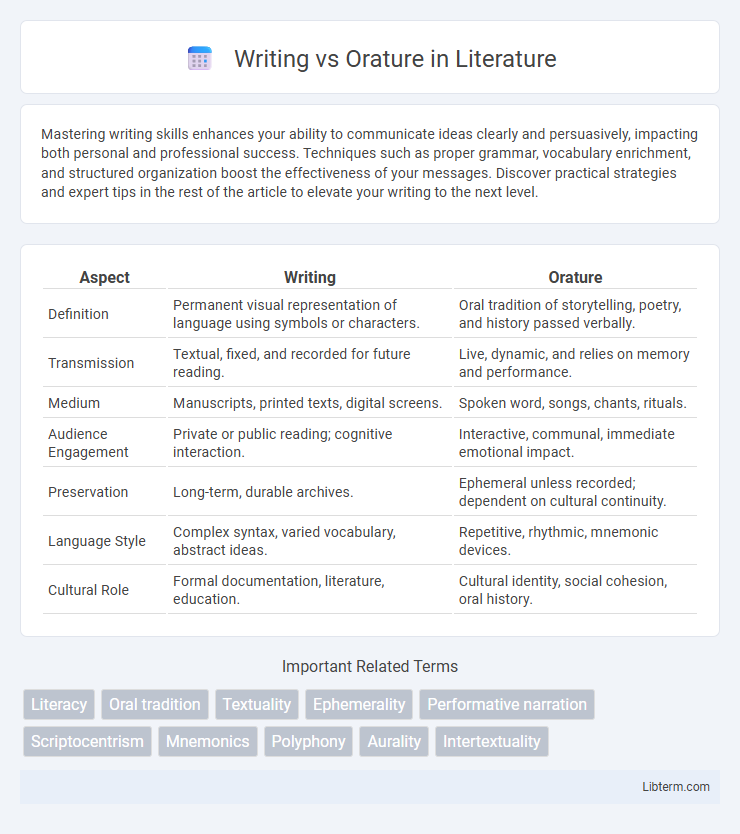Mastering writing skills enhances your ability to communicate ideas clearly and persuasively, impacting both personal and professional success. Techniques such as proper grammar, vocabulary enrichment, and structured organization boost the effectiveness of your messages. Discover practical strategies and expert tips in the rest of the article to elevate your writing to the next level.
Table of Comparison
| Aspect | Writing | Orature |
|---|---|---|
| Definition | Permanent visual representation of language using symbols or characters. | Oral tradition of storytelling, poetry, and history passed verbally. |
| Transmission | Textual, fixed, and recorded for future reading. | Live, dynamic, and relies on memory and performance. |
| Medium | Manuscripts, printed texts, digital screens. | Spoken word, songs, chants, rituals. |
| Audience Engagement | Private or public reading; cognitive interaction. | Interactive, communal, immediate emotional impact. |
| Preservation | Long-term, durable archives. | Ephemeral unless recorded; dependent on cultural continuity. |
| Language Style | Complex syntax, varied vocabulary, abstract ideas. | Repetitive, rhythmic, mnemonic devices. |
| Cultural Role | Formal documentation, literature, education. | Cultural identity, social cohesion, oral history. |
Defining Writing and Orature
Writing is the systematic representation of language through visually perceptible symbols, enabling the documentation and transmission of information across time and space. Orature, by contrast, encompasses the oral traditions and verbal art forms, including storytelling, poetry, and songs, that rely on spoken word and memory for cultural expression and preservation. Both writing and orature serve as vital channels for communication, with writing providing permanence and orature emphasizing communal interaction and performative elements.
Historical Evolution of Communication
The historical evolution of communication reveals distinct trajectories between writing and orature, with writing emerging as a permanent, visual record system, transforming ancient societies through literacy and bureaucratic organization. Orature, encompassing oral traditions and spoken narratives, dominated preliterate cultures, facilitating communal memory and social cohesion via storytelling, poetry, and ritual performances. The shift from orature to writing marked a pivotal transition in information dissemination, enabling the preservation of complex knowledge and the development of civilizations.
Key Characteristics of Writing
Writing is a permanent, visual representation of language that employs symbols such as alphabets, characters, or ideograms to convey complex ideas across time and space. It allows for precise organization and revision of thoughts, facilitating detailed record-keeping, legal documentation, and scholarly communication. Unlike orature, writing enables dissemination of information independent of the author's presence, supporting widespread literacy and historical preservation.
Key Characteristics of Orature
Orature is an oral tradition characterized by its performance-based delivery, community participation, and reliance on memory and improvisation. It emphasizes storytelling, song, and poetry passed down through generations without written records, preserving cultural heritage in fluid and adaptive forms. Unlike writing, orature is dynamic, context-dependent, and often integrates non-verbal cues such as gestures and intonation to enhance meaning.
Preservation and Transmission of Knowledge
Writing enables precise preservation and transmission of knowledge through durable physical records such as manuscripts and digital documents, ensuring longevity and widespread accessibility across time and space. Orature, encompassing oral traditions, relies on memory, performance, and communal participation, facilitating dynamic transmission but facing challenges of alteration and loss over generations. Both methods complement each other: writing safeguards fixed knowledge, while orature preserves cultural context and adaptability within living communities.
Role of Memory in Orature
Memory serves as a fundamental pillar in orature, enabling the accurate transmission of stories, traditions, and cultural values across generations without written records. Unlike writing, which externalizes information into physical texts, orature relies on the human cognitive capacity to memorize and perform narratives, preserving communal identity and historical continuity. This oral transmission strengthens communal bonds and adapts fluidly to changes while safeguarding the essence of cultural heritage.
Impact on Culture and Identity
Writing preserves complex cultural narratives and historical records with precision, enabling societies to maintain a consistent identity across generations. Orature, characterized by oral storytelling and performance, fosters communal participation and immediate cultural expression, reinforcing social bonds and collective memory. Both mediums significantly shape cultural identity by transmitting values, traditions, and knowledge in distinct but complementary ways.
Adaptation in Modern Society
Adaptation in modern society requires a nuanced understanding of writing and orature as complementary communication forms, where writing preserves complex ideas for widespread dissemination while orature thrives in dynamic, oral traditions that foster immediate community engagement. The rise of digital media platforms has transformed traditional orature by enabling oral narratives to reach global audiences, enhancing cultural preservation with modern technological tools. Integrating writing and orature effectively supports cultural diversity and knowledge transmission in an increasingly interconnected world.
Challenges Facing Orature Today
Orature faces significant challenges today due to the dominance of written culture, which often marginalizes oral traditions in education and media. The ephemeral nature of orature makes it vulnerable to loss as younger generations increasingly prefer digital and written forms of communication. Efforts to preserve and document orature are crucial to maintain the cultural heritage embedded in oral narratives, songs, and performances.
Synergy Between Writing and Orature
The synergy between writing and orature enhances cultural preservation by combining the permanence of written records with the dynamic, performative nature of oral traditions. This interplay allows stories, histories, and knowledge to be transmitted across generations while adapting to contemporary contexts and audiences. Leveraging both mediums enriches the authenticity and accessibility of cultural narratives, fostering a more holistic understanding of heritage.
Writing Infographic

 libterm.com
libterm.com